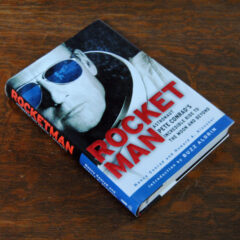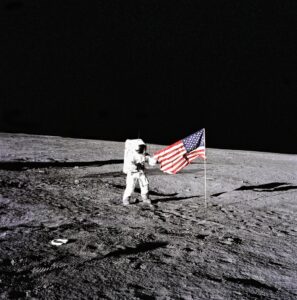
Pete Conrad’s biography is not a cookie-cutter story. Then again, there was nothing cookie-cutter about him. He was, as his headstone implies, “An Original.” Co-written by his second wife Nancy Conrad and Howard A. Klausner, the writer of Space Cowboys, this biography is presented cinematically, but it would have been a thrilling ride anyway.
Honestly, if ever you needed proof that you can have fun and enjoy a serious job with a smile on your face, then Pete Conrad is exhibit A for astronauts.
As I said, the structure is cinematic in that it bounces back and forth between Charles “Pete” Conrad’s linear life story and his attempt with three other pilots that were “having a go at the round the world-speed record: 24,000 miles in under fifty hours in a business-class jet.”
That cinematic quality and Klausner’s screenwriting background definitely make this biography an easy and entertaining read. Why did Nancy Conrad choose Klausner? It’s covered in the acknowledgments, where Nancy says that she had covered a lot of this book just prior to the accident that claimed Pete’s life, and she was looking for someone to help bring the story to life.
Eventually, she was introduced to Klausner and as he recounts in his part of the acknowledgments:
“Well,” she began, “as you know, he was tossed from the Mercury Program because he had an attitude problem…”
No, I didn’t know. Or I’d forgotten. It had been a long time since I’d read The Right Stuff, and what I did know about Conrad was pretty much the sanitized, NASA-approved PR version of his life. That was the first of many consciousness shifters that day–like the fact that the Moon didn’t mean all that much to Pete. Not compared to Skylab, and the commercialization of space, the thing both he and Nancy were working on at the leading edge when he died.
 Normally, the who and how behind the book is secondary to the content, but in this case, it explains just why it is so compelling. Not only is Pete Conrad an incredible subject, but Nancy Conrad and Klausner didn’t want to tell the “sanitized, NASA-approved PR version of his life” — they wanted to tell the whole story.
Normally, the who and how behind the book is secondary to the content, but in this case, it explains just why it is so compelling. Not only is Pete Conrad an incredible subject, but Nancy Conrad and Klausner didn’t want to tell the “sanitized, NASA-approved PR version of his life” — they wanted to tell the whole story.
And while Pete’s story of falling in love with flying at an early age is very similar to the other astronauts of his ilk that set foot on the Moon, or had a hand in Mercury, Gemini, or Apollo, the story is not so similar anywhere else.
In overcoming his undiagnosed dyslexia at a young age, working with his now well-known attitude problem (which could have made him more of a household name like Shepard or Glenn), and developing an absolute love for Skylab, even more so than the lunar mission, Pete Conrad’s story is aspirational.
As Buzz Aldrin writes in the book’s introduction, “This book is the story of a man — a man who embodied the very spirit behind the space program. Charles ‘Pete’ Conrad was a great pilot, a gifted engineer, a problem solver, and a natural-born leader.”
And that spirit is captured in this book, even to a fault. The two most obvious examples of this are the pieces of truth obvious to anyone who has done any hard reading about NASA during the Apollo years:
“There were a thousand people working into the night down here at the Cape, preparing — on a Sunday. A thousand moreover in Houston. Nobody ever seemed to pay attention to the shift whistle on this job. Nobody ever wanted to leave.”
“An astronaut’s day was not nine to five — that was for damn sure. As checklist- and procedure-oriented as that work was, Pete’s life had never known routine. Not really. “
Both of these statements are the very reason that when people came out of NASA either at the end of Apollo or when their time was up, it was a hard landing. For Pete, it was with divorce but also a sense of loss. When you work that hard for that long doing something bigger than yourself, it’s hard to just go do a regular 9-to-5.
 When he did get out of NASA, he landed at McDonnell Douglas Aircraft where James S. “Old Mac” McDonnell hired him. Sadly, Pete’s experience when Old Mac died, is something that I understand all too well, even having never been a pilot myself.
When he did get out of NASA, he landed at McDonnell Douglas Aircraft where James S. “Old Mac” McDonnell hired him. Sadly, Pete’s experience when Old Mac died, is something that I understand all too well, even having never been a pilot myself.
“Old Mac had hired Pete because he was a people guy, a pilot, and a straight shooter. Suddenly those didn’t seem to be assets in the MBA-worshiping corporate climate of the eighties. Old Mac was gone, and Pete Conrad wasn’t flying their jets much anymore. He was pushing paper around a desk.”
Charles “Pete” Conrad’s story is not just for those interested in the Apollo era of NASA. It’s for everyone who is looking for something bigger, a purpose or a passion. This book is not a roadmap by any definition, but it is aspirational and thought-provoking.
The stories and their delivery are thoughtfully put together by authors Nancy Conrad and Klausner in a way that not only feels authentic to Pete but to the things he stood for and believed in.
This is one of the few NASA books I will be recommending to non-NASAphiles. Pick it up. It’s worth your time.